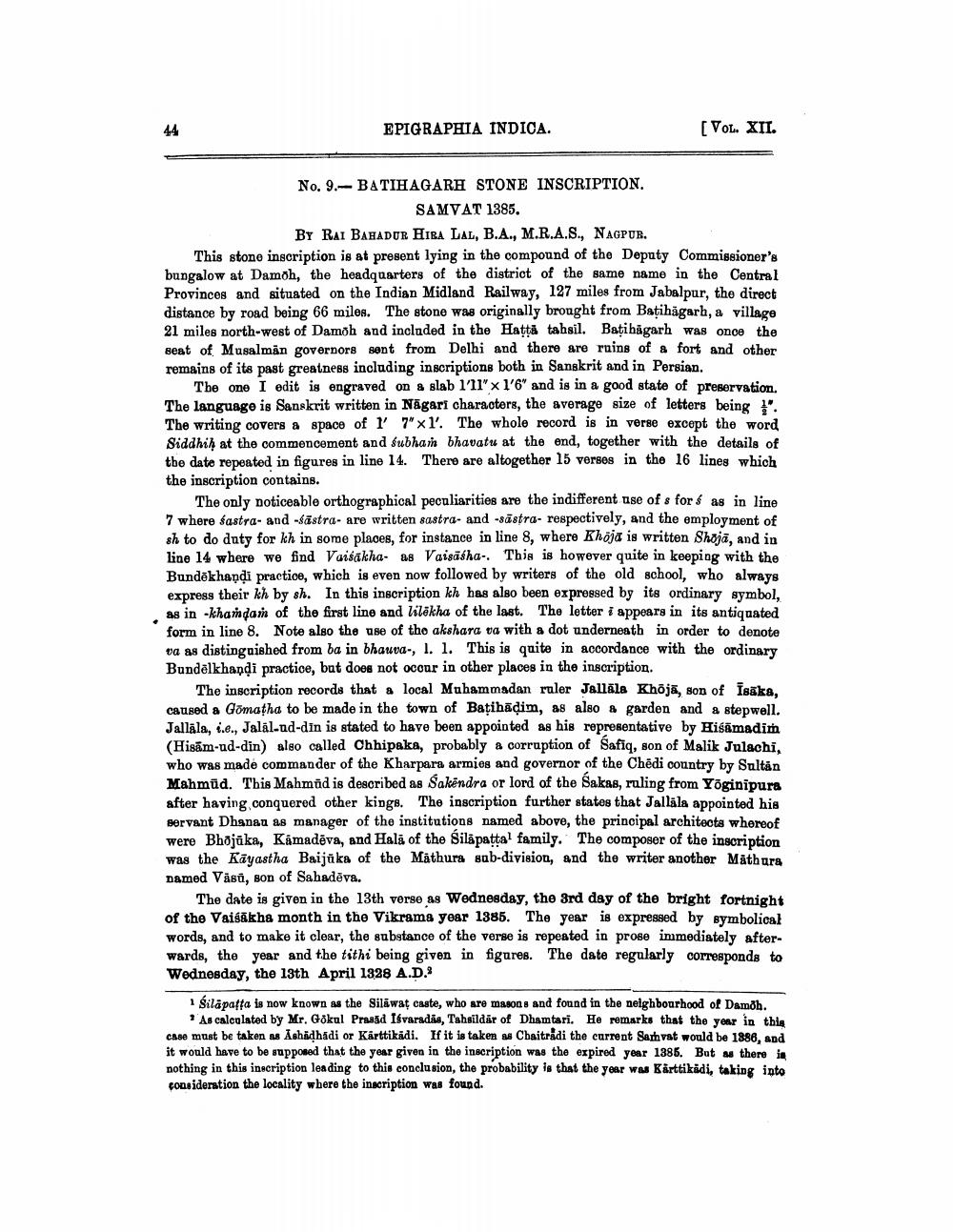________________
EPIGRAPHIA INDICA.
[VOL. XII.
No. 9.-BATIHAGARH STONE INSCRIPTION.
SAMVAT 1385. BY RAI BAHADUR HIBA LAL, B.A., M.R.A.S., NAGPUR. This stone inscription is at present lying in the compound of the Deputy Commissioner's bungalow at Damoh, the headquarters of the district of the same name in the Central Provinces and situated on the Indian Midland Railway, 127 miles from Jabalpur, the direct distance by road being 66 miles. The stone was originally brought from Batihägarh, a village 21 miles north-west of Damoh and included in the Hattā tahsil. Batibăgarh was once the seat of Musalman governors sont from Delhi and there are ruins of a fort and other remains of its past greatness including inscriptions both in Sanskrit and in Persian.
The one I edit is engraved on a slab 1'11" x 1'6" and is in a good state of preservation. The language is Sanskrit written in Nāgari characters, the average size of letters being ?". The writing covers a space of 1' 7"x1'. The whole record is in verge except the word Siddhill at the commencement and Subhan bhavatu at the end, together with the details of the date repeated in figures in line 14. There are altogether 15 verses in the 16 lines which the inscription contains.
The only noticeable orthographical peculiarities are the indifferent use of s for $ as in line 7 where sastra- and -sästra- are written sastra- and -sõstra- respectively, and the employment of sh to do duty for kh in some places, for instance in line 8, where Khõja is written Shojā, and in line 14 where we find Vaisakha- as Vaisāíha.. This is however quite in keeping with the Bundēkhandi practice, which is even now followed by writers of the old school, who always express their kh by sh. In this inscription kh has also been expressed by its ordinary symbol, as in -khandan of the first line and lilēkha of the last. The letter i appears in its antiquated form in line 8. Note also the use of the akshara va with a dot underneath in order to denote va as distinguished from ba in bhauva-, 1. 1. This is quite in accordance with the ordinary Bundelkhandi practice, bat does not occur in other places in the inscription.
The inscription records that a local Muhammadan ruler Jallála Khojā, son of Isaka, caused a Gomatha to be made in the town of Baţihādim, as also a garden and a stepwell. Jallala, i.e., Jalal-ud-din is stated to have been appointed as his representative by Hisämadim (Hisām-ud-din) also called Chhipaka, probably & corruption of Safiq, son of Malik Julachi. who was made commander of the Kharpara armies and governor of the Chēdi country by Sultan Mahmud. This Mahmäd is described as Sakēndra or lord of the Sakas, ruling from Yöginipura after having conquered other kings. The inscription further states that Jallala appointed his servant Dhanau as manager of the institutions named above, the principal architects whereof were Bhojāka, Kámadēva, and Hala of the Silapattal family. The composer of the inscription was the Kayastha Baijāka of the Mathura sub-division, and the writer another Mathura named Väsi, son of Sahadēva.
The date is given in the 13th verse as Wednesday, the 3rd day of the bright fortnight of the Vaisakha month in the Vikrams year 1385. The year is expressed by symbolical words, and to make it clear, the substance of the verse is repeated in prose immediately afterwards, the year and the tithi being given in figures. The date regularly corresponds to Wednesday, the 13th April 1328 A.D.
1 silapatta is now known as the Silawat caste, who are masons and found in the neighbourhood of Damoh.
* As calculated by Mr. Gokul Prasad Isvaradás, Tahsildar of Dhamtari. He remarks that the year in this case must be taken as Ashidhadi or Kärttikadi. If it is taken as Chaitradi the current Samvat would be 1886, and it would have to be supposed that the year given in the inscription was the expired year 1385. But as there in nothing in this inscription leading to this conclusion, the probability is that the year was Kärttikädi, taking into consideration the locality where the inscription was found.




